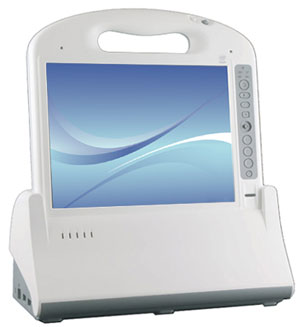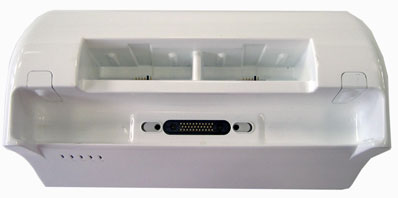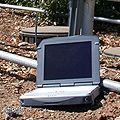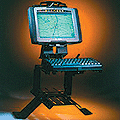Update September 2012: The Gammatech MT10 remains in the company's lineup, though along the way the name changed to T10L and the tablet received fairly substantial tech updates that include a switch to the 1.6GHz Intel N450 processor and Windows 7. In the meantime, Gammatech introduced the T10L2 powered by a dual-core 1.8GHz Intel Atom D525 processor and a multi-touch display.
On March 23, 2009 GammaTech Computer Corporation, which is the North American/Latin American sales and marketing arm of Taiwanese Twinhead, joined the growing number of companies offering medical slates based on Intel's mobile clinical assistant reference architecture.  The GammaTech Durabook MT10 MCA is yet another design that follows Intel's original proof of concept platform with its tablet form factor and integrated multi-purpose handle for easy carrying and use during a clinical environment work shift. The device is also listed in Twinhead's own lineup where it is the DigiHeal T10Y MCA Series (do all MCAs need funny sounding names?) Further, TabletKiosk also seems to carry this machine as the MediSlate MCA i1040XT.
The GammaTech Durabook MT10 MCA is yet another design that follows Intel's original proof of concept platform with its tablet form factor and integrated multi-purpose handle for easy carrying and use during a clinical environment work shift. The device is also listed in Twinhead's own lineup where it is the DigiHeal T10Y MCA Series (do all MCAs need funny sounding names?) Further, TabletKiosk also seems to carry this machine as the MediSlate MCA i1040XT.
GammaTech's medical slate is a timely entry into a market that may see significant growth over the next few years. That's because the US Federal Economic Stimulus legislation that passed Congress and was signed by President Obama in February 2009 includes almost US$20 billion to modernize health care systems, including a switch to electronic patient records for all Americans by the year 2014. This can translate into a lot of potential business, but Twinhead/GammaTech is entering a market where the competition has a good head start. Motion Computing entered the MCA market two years ago with their C5 Mobile Clinical Assistant, a machine that's been very well received. The Panasonic H1 Mobile Clinical Assistant was introduced in November 2008, drawing on Panasonic's massive resources. Fujitsu is testing the market with the Esprimo MA "Personal Healthcare Assistant", and embedded and industrial systems specialist Advantech has the Atom-based MICA-101. Twinhead, of course, has substantial experience in building semi-rugged notebooks as well, so how does the mt10/DigiHeal stack up against the competition?
The overall design, form factor and implementation is more or less determined by Intel's original reference design, and the mt10 does that with a slate that has a footprint of 10.6 x 10.1 inches and is 1.4 inches thick. It starts at about 3.3 pounds including batteries, and has the integrated carry handle Intel mandated an MCA should have.
Since MCAs are meant to improve workflow, ease workloads, and reduce errors, Intel also specified inclusion of a wealth of data capture technologies. The Twinhead/GammaTech machine has an integrated 1D/2D barcode scanner option, a 13.56MHz RFID reader option with ISO 14443A/B and ISO 15693 support, a biometric fingerprint reader, and also a 2-megapixel web-enabled camera that can also capture video.
On the technology side, Twinhead/GammaTech opted to go Intel Core instead of Atom, selecting the 1.06GHz Intel Core 2 Solo U2100 ULV processor, an ultra low power chip with a maximum thermal design power of 5.5 watts. The machine comes with 2GB of 533/667MHz DDR2 SDRAM, a shock-mounted 4,200rpm 60GB 1.8-inch SATA hard disk or an optional 32GB SSD, and a 10.4-inch TFT touch screen display with 1024 x 768 pixel XGA resolution. There's 802.11a/b/g/n WiFi, Bluetooth 2.1 + EDR, and an optional 3G WWAN module.

While TabletKiosk refers to their version of this machine as "semi-rugged," GammaTech confidently calls it "fully rugged" and Twinhead refers to their own version as "fully sealed and water-proof." Fact is that these mobile clinical assistant computers should be somewhat drop-resistant and spill-proof as well as easy to be wiped clean and disinfected so as to help reduce the spreading of germs. Infection control is a major issue in clinical settings, and mandates frequent spraying and wiping of the unit with disinfectant that the MCA must be able to handle. How did Twinhead/GammaTech address those serious requirements?
Unfortunately, the specs are a bit unclear:
- Twinhead lists both a 3-foot and a 4-foot drop. GammaTech's release claims four feet.
- Both claim IP54 sealing, which is described as "fully sealed" and "water-proof." That is misleading as IP54 allows limited dust ingress and also limited water ingress.
- GammaTech's brochure claims the mt10 meets Military 810F Standard.
To be honest, that is a little weak, and something as important as sealing and ruggedness should be described more precisely and accurately.
How does the Twinhead/GammaTech MCA compare to the competition? It's a clean, elegant design and closely follows the Intel reference architecture. Twinhead followed Panasonic's lead with dual batteries which enables hot-swappable operation when away from the dock. If the drop-spec is indeed 4-foot, it would exceed the competition, but the specs are unclear.
Twinhead missed in other areas. The Intel Core 2 Solo is a competent processor but the competition now mostly uses the newer and more power-efficient Atom z5xx chips that have much lower thermal design power and run cooler. As a result, the claimed battery life (up to 4.5 hours) is good, but not great. If the mt10 uses the same display as the TabletKiosk version, it has anti-glare treatment and claims daylight readability with a 240 nits LED backlight—lagging behind Motion's excellent View Anywhere screen and Panasonic's very bright 500 nits display. In terms of operation, the mt10 only has a 4-wire resistive touchscreen whereas the competition offers either electromagnetic digitizers or both touch and active digitizers. Offering touch only in an environment where minimal contamination matters is not a good choice. And while competitors like the Panasonic Toughbook H1 are truly easy to clean, the mt10 has a few slots and holes where bacteria can hide, and the screw holes are not covered as they are in competing designs.
Neither the GammaTech website nor the mt10 press release list pricing. In order to be competitive, the machine would have to sell below Motion's base model C5 (US$2,199) which has a faster processor and offers more configuration choices, or the Panasonic H1 which offers a brighter display, longer battery life and a dual digitizer. Twinhead knows how to build excellent vertical market computers, but this initial MCA offering does not quite convince.












